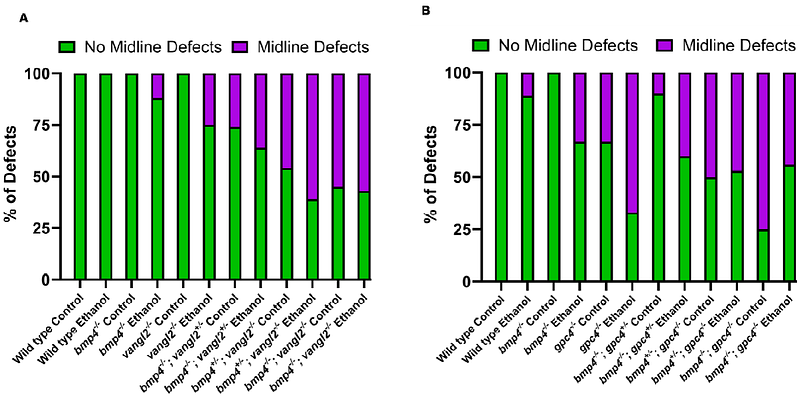Interactions between the Bone Morphogenetic Protein and the Planar Cell Polarity Pathways lead to distinctive ethanol-induced facial defects

Interactions between the Bone Morphogenetic Protein and the Planar Cell Polarity Pathways lead to distinctive ethanol-induced facial defects
Gray, R.; Llyod, A.; Lovely, C. B.
AbstractBackgroundFetal Alcohol Spectrum Disorders (FASD) describes a spectrum of ethanol-induced neural and facial developmental defects. Ethanol susceptibility is modulated by genetics, but their underlying mechanisms remain poorly understood. In all vertebrates, a series of complex cellular events give rise to the body plan, including convergence & extension (C&E) and endoderm/ cranial neural crest (CNC-which gives rise to the facial skeleton) morphogenesis. These events are critical to establish complex signaling interactions, driving embryo development, including the facial skeleton. In zebrafish, C&E occurs between 6-10 hpf while endoderm/CNC morphogenesis occurs 10-24 hpf. Previous work shows that the PCP mutants are sensitive to ethanol from 6-24 hpf, covering both C&E and endoderm/CNC morphogenesis and exhibiting multiple defects to the forming head raising the question whether ethanol during both time windows drives PCP-ethanol defects. We hypothesize that PCP single and double mutants are ethanol sensitive 10-24 hpf, after C&E. We also hypothesize BMP signaling (sensitive 10-18 hpf) interacts with and sensitizes the PCP pathway to ethanol. MethodsHere, we treated PCP/BMP mutants with ethanol from 6-10, 10-18, 10-24 or 24-30 hpf and combined morphometric and linear measurements to examine facial development. ResultsWe show that PCP mutant larvae are ethanol-sensitive from 10-24 hpf, but not 6-10 or 24-30 hpf. We also show that BMP mutants sensitize PCP mutants to ethanol and lead to novel ethanol-independent midline craniofacial defects. Our results suggest that the ethanol-sensitive role of PCP pathway occurs after C&E, during endoderm/CNC morphogenesis and that the PCP and BMP pathways genetically interact during the morphogenesis events. ConclusionsUltimately, our work builds on a mechanistic paradigm of ethanol-induced birth defects we have been developing, connecting conceptual framework with concrete cellular events that could be ethanol-sensitive beyond facial development.